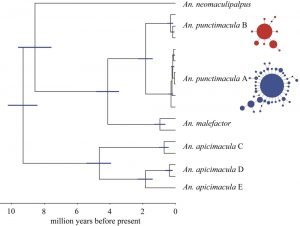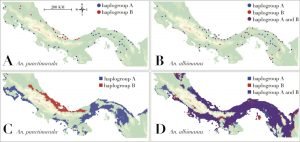Anopheles Phylogeography
Principal investigators: Jose R. Loaiza
Collaborators:Jan E. Conn, Sara Bickersmith & Matthew J. Miller
Background
Phylogeographic studies from a variety of Anophelesmosquitoes – the principle vector of human malaria – share a consistent signal of historical demographic instability, which is generally believed to be due to environmental variation during the Pleistocene. -Temperature, rainfall and sea level oscillated remarkably during this climatic period, likely affecting availability of larval breeding habitats for many Anophelesspecies around the world, including vectors and non-vectors of human plasmodia. The consensus from this body of work suggests that geographically overlapping Anopheles species suffered similar and drastic variation in effective population sizes due to past environmental instability, ultimately resulting in shared signatures of phylogeographic history. Not all Anophelesmosquitoes share the same ecological niche though, and therefore have different demographic and population trends under contemporary circumstances.
We use a combination of phylogeographic and ecological niche modeling approaches to predict the demographic history of human malaria vector species in Lower Mesoamerica, including, Anopheles (Anopheles) punctimacula s.l. andAnopheles (Nyssorhynchus) albimanus, and to evaluate the role of historical and contemporary ecological forces in shaping the differences in mitochondrial genetic variation observed between these two species.
Findings & developments
- Anopheles punctimacula(i.e. a forest specialist) shows signals of severe refugial isolation during the LGM plus ongoing restriction to gene flow due to adaptation to different climatic regimes (i.e. niche diversification). In contrast, Anopheles albimanus(i.e. a habitat colonist) shows signals of more continuous suitable habitat at the LGM and contemporary niche homogenization due to extensive contemporary gene flow (i.e. lack of niche diversification).
- We noticed that comparative phylogeographic studies involving habitat specialist and colonist Anophelesspecies, can ultimately aid to forecast the roles of evolutionary history and ecology in shaping regional patterns of malaria transmission.
- We suggest that ecological plasticity and resilience to climatic instability may contribute to the role of An. albimanusas the principal vector of Plasmodium in Mesoamerica. Also, it is possible that the two clades of An. punctimacula found across Panama and Costa Rica are at least partially reproductively isolated, and may be better considered as incipient species.
Relevant publications
- Loaiza JR., † Scott M, Bermingham E, Sanjur OI, Wilkerson RC, Rovira J, et al. 2010. Late Pleistocene environmental changes lead to unstable demography and population divergence of Anopheles albimanus in the northern Neotropics. Molecular Phylogenetics and Evolution 57:1341-1346.
- Loaiza JR., † Bermingham E, Sanjur OI, Scott ME, Bickersmith SA, Conn JE. 2012. Review of genetic diversity in malaria vectors (Culicidae: Anophelinae). Infection Genetics and Evolution 12(1):1-12.
- Loaiza JR.†, Mathew Miller 2019. Historical and contemporary forces combine to shape patterns of genetic differentiation in two species of Mesoamerican Anopheles mosquitoes. Biological Journal of the Linnaean Society, 126(1):146–157.


